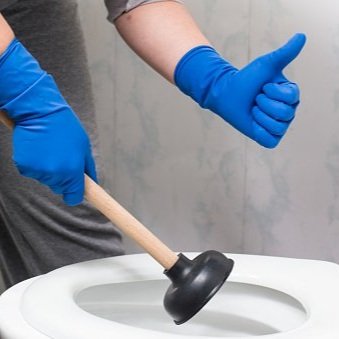Bathroom Upkeep: How to Deal With a Toilet Clog
Until something goes wrong, we rarely give our toilets a second thought. But without a plunger, a broken or clogged toilet can be more than a minor inconvenience. A clogged toilet can completely disrupt a family's daily activities.
In most cases, clearing a blockage is just a matter of plunging the drain. However, this isn't always the case. Let's talk about how to unclog a toilet with or without a plunger.
With a plunger
In most circumstances, it's possible to unclog a toilet with a flange plunger. Plungers with flanges are designed exclusively for toilet use. "Flange" refers to a sleeve-like rubber flap built into the underside of the plunger's rubber cup. To ensure a more secure seal than a traditional cup plunger, place this flange directly into the drain hole of the toilet bowl.
We recommend using gloves and protecting the nearby surfaces with towels or plastic wraps. Then follow these steps:
Fill the toilet bowl about halfway with water to get the most out of the plunger. As a result, the flange should fit snugly into the top of the toilet bowl drain.
Make sure the flap fills up with water as you lower the flange. Allow water from the bowl to flow under the cup as the seal is formed. The water between the cup and the drain will create suction pressure, clearing the clog.
"Test" it out. Begin by pressing the plunger down and then slowly pulling it back up in the same way. Throughout the process, make sure the seal remains in place.
Start plunging by putting a lot of pressure on the plunger, so the cup sinks and drives the flange into the drain.
Pull up on the plunger to "reset" it. For a total of 20 seconds, go through the motions slowly and steadily.
Break the seal and remove the plunger after 30 seconds of plunging.
Observe the water level in the toilet bowl and listen for the sound of gurgling. If almost all of the water in the bowl has drained, then the clog was most likely cleared.
Repeat this process as much as necessary.
Use dish soap or baking soda
The natural properties of dish soap break down solids like grease and grime. Here's how to manage a toilet clog with this method:
Squirt a generous amount of soap down the drain of the toilet.
Immediately following the soap, use a bucket of hot water (not boiling). Porcelain can crack if the water is too hot.
Try again after a half-hour.
If necessary, repeat the procedure.
Alternatively, put some baking soda down the toilet's drain. You should add the vinegar gradually. You can clear clogs in about an hour with a chemical reaction. As previously mentioned, a bucket of hot water is a helpful follow-up. If necessary, repeat the procedure.
If nothing works, please hire a professional to solve the issue and get back to a fully functional toilet.
911 Heating, Cooling & Plumbing provides quality residential plumbing, commercial plumbing, sink drains and sewers, slab leak detection and repair, and water heater repair and replacement services to Phoenix, AZ, residents at affordable prices. Contact us at 602-795-2900 for all your plumbing needs.

